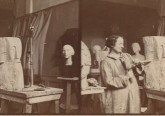October 15, 2008 to February 15, 2009
The Pinothèque de Paris is presenting an exceptional group of works by Jackson Pollock inspired by Amerindian shamanism in Paris for the first time in 26 years, from October 15 to February 15. A chance to discover a different aspect of the American painter than the usual “drippings” and learn about his sources of inspiration and his spiritual transformation.
 Untitled – Equine series IV© Adagp, Paris 2008
Untitled – Equine series IV© Adagp, Paris 2008The unusual perspective adopted for this exhibition offers fresh insight into the artist's working method, shedding light on the process of shamanic spiritual transformation pursued by Pollock. Based on an idea of Stephen Polcari, author of the seminal work on the movement of “American Abstract Expressionism”, the show aims to explore a new interpretation of Pollock's work by demonstrating that the artist's sources of inspiration were rooted in Amerindian shamanism.
Aim of the exhibition
Until now, Pollock's fascination with Amerindian art and rituals and their influence on his work have never been the subject of serious study. The exhibition has chosen to examine this essential issue. It reveals Pollock's idea of the unconscious as an illustration of Indian rituals and shamanism. With drawings and important paintings selected from his abstract and semi-abstract works, it displays his images and forms and compares them with the shamanist imagination, offering a hitherto neglected perspective even though this influence has been readily acknowledged.
 Figure Knealing before Arch with Skulls© Adagp, Paris 2008
Figure Knealing before Arch with Skulls© Adagp, Paris 2008Like the Surrealists, Pollock is known to have been keenly interested in anything related to the unconscious. After World War II, in reaction to the uncertainties of modern American society, Pollock seems to have viewed shamanism as an effective means to achieve “spiritual transformation.” As an artist, he undoubtedly went the farthest in this direction. It is generally accepted that Jackson Pollock saw the origins of art in the sources of the unconscious. Yet while Pollock often stated this belief, he never explained what he meant by the unconscious. Since the 1950s, following the first wave of interpreters of his work, it has been widely held that his art flowed from his own psyche. This rather facile interpretation stemmed from knowledge of the artist's volatile character, particularly his reputation as a heavy drinker. This highly Freudian approach is now considered to have limited Pollock's work to reflecting his dreams and everyday fantasies, problems and pain. In the meantime, other interpretations have been introduced to supplement this aspect, particularly as a result of in-depth study of his formative years (the 1930s and 1940s).
 Man, Bull, Bird© Adagp, Paris 2008
Man, Bull, Bird© Adagp, Paris 2008At the time, Pollock underwent four years of Jungian analysis. The influence of Jung's psychoanalytic approach is now more or less accepted, especially the impact of the collective unconscious in Pollock's work. Another idea has since become established, which goes beyond this interpretation. During the 1930s and 1940s, the unconscious was considered a thinking process that involved a “primitive” reflex, i.e. a form of consciousness that could still be found in non-western peoples. Pollock was attracted to this idea by his friend, the artist John Graham, a Russian émigré who combined the art of Picasso with “primitivism” and the unconscious. In keeping with this approach, Pollock's work can be far more easily understood through a comparison with the images and rituals of American Indians, particularly Navajo sand paintings, and directly linked to shamanistic rituals. Indeed, his quest for spiritual transformation led him to attempt to find the means to reconcile himself with life in the symbolic figure of the shaman. Shamanism expresses the relationship between human beings and creation, according to the peoples that adopted it as a spiritual practice and as a mode of relating to the world. It encompasses a set of beliefs, rituals and practices intended to create a harmonious bond between human beings and the universe.
Thematic exploration
 Untitled ( number 25)© Adagp, Paris 2008
Untitled ( number 25)© Adagp, Paris 2008Major paintings were to reveal Pollock's repeated borrowings from this shamanic process, both in semi-abstract works such as Birth, Untitled (Bald Woman with Skeleton) and Man, Bull, Bird and in pure abstraction with the famous “dripping” canvases. Alongside the selection of some thirty works by Pollock from international museums and major private collections, the exhibition proposes a sensitive journey into his sources of shamanic inspiration by presenting an outstanding group of ritual and decorative objects brought together for the first time from the peoples of the Pacific Northwest and the Far North: rattles, masks, a soul catcher, an amulet, a totem pole, etc. The works and objects on display clearly show the repetitive forms and images that Pollock drew from Indian art.
The search for shamanic influences is extended through two films: the first from 1930 on the traditional culture of the Kwakiutl Indians: 'The Kwakiutl of British Columbia' by Franck Boas and B. Holm, the second from 1914-1972 on the epic tale of the Kwatkiutl of the Pacific Northwest: “The Land of the War Canoes” by Edward Curtis. Finally, to illustrate the Surrealists' interest in shamanism, the exhibition displays a few important works by André Masson.
- October 15 —, February 15, 2009
- La Pinacothèque de Paris, 28, place de la Madeleine _75 008 Paris
- Telephone : 01 42 68 02 01
- Artistic Director: Marc Restellini, assisted by Hélène Desmazières and Alexandre Curnier
- Scientific Commissariat : Stephen Polcari, assisted by Jenny G. Chevallier
- Scientific Committee: Samuel Sachs, president of the Pollock-Krasner Foundation, Susan Davidson, curator of the Solomon R. Guggenheim Museum, Joan Washburn, Pollock Estate.
- Scenography: Laurent Guinamard —,Casati
Publications
-Abstract Expressionism and the Modern Experience,
-Stephen Polcari, Professor or Art History at Chapman University.
-Portfolio no. 3 Jackson Pollock
-Éditions Pinacothèque de Paris
-Format: 33 x 35 cm
Par






Ajouter un commentaire